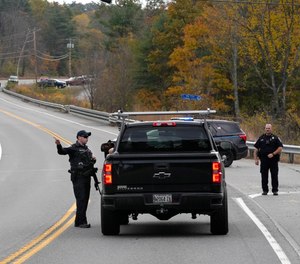At 6:56 p.m., on October 25, 2023, Lewiston (Maine) Police Department officers were dispatched to an in-progress mass shooting at the Just-In-Time Bowling Alley in Lewiston. While police were still responding to this event, a second mass shooting event was called in four miles away at the Schemengees Bar and Grille.
Robert Card, the suspected shooter, was armed with a .308 rifle equipped with optics. Card represents an example of a hybrid active killer in that he trained extensively and planned meticulously, after which he struck once and struck again. Then he fled the scene. At both locations combined, he killed 18 and wounded 13.
If there is any positive news, we do not have to change what we have found to be “best practices” for responding to an active killer. For your review, here are a few of those best practices:

Police officers speak with a motorist at a roadblock. (AP Photo/Robert F. Bukaty)
1. Whenever possible, effectively intervene before the event, during the five phases of the active shooter, which are:
- Fantasy phase
- Planning phase
- Preparation phase
- Approach phase
- Implementation phase
In the Card example, there was a demonstration of what has been commonly called “leakage,” which occurs in most of these cases and can allow for intervention in the early phases. Card, an Army Reservist, received psychiatric treatment in July 2023 after he disclosed that he had been “hearing voices” and expressed a desire to harm his military base. His commander facilitated this intervention.
Card was treated for two weeks and released. Maines’ “Yellow Flag Law” was not utilized here, which allows the temporary removal of weapons from a person who may be in danger of hurting themselves or others.
Effective intervention can save lives. This case proves that ineffective intervention, or none at all, will not.
2. To prepare for their own active killer, officers may also travel through their own alternative five phases. These phases can be:
- Fantasy (except it is no fantasy) phase: When/then think, while on patrol and even off duty. While at specific stores, taverns, or churches, both on duty and off, mentally choose the best approach, weapon of choice, and tactics on contact that you will use when an attack takes place. When/then thinking is powerful preparation.
- Planning phase: Plan on being dispatched to an “active killer” call someday and develop in advance an ”I will prevail” attitude coupled with the skills to prevail.
- Preparation phase: To ensure victory, the key is relentless preparation. You must continuously train in all the skills that will empower you to prevail.
- Approach phase: Whether on duty or off, on a call, or on patrol, approach every gas station, restaurant, school, church and prowler call with a heightened awareness. Scan and assess as you deliberately break up your tunnel vision on every approach. Form a habit of trying to get as close to your destination without being seen or heard. On every approach use available cover and concealment, while maintaining your options for tactical movement. In the event that someone prepares an ambush for you, this exercise will ensure you will be the surprise-er not the surprise-ee, when lives are on the line.
- Implementation phase: When the suspect implements his plan, you may not have superior numbers or weaponry, but you will prevail by possessing a superior attitude, superior skills and superior tactics.
3. Once again, arrive unseen …
… because the hybrid killer has prepared for your arrival, get as close to the killer as possible before he or she is aware of your presence.
4. One is better than none …
… when the killing is in progress. Remember that as an honorable gunfighter, you are the single ingredient needed to end the killing of a mass murderer.
5. Use the chaos as your diversion …
… as you move toward the killer. There may be people screaming and fleeing for their lives. Others may be dead or wounded. As the only officer on scene who can stop the killing you must, as Officer Zach Robinson of the Fargo Police Department told me, “push past” the scenes of carnage to move to the killer.
6. Gather and pass along intelligence on the move …
… by conducting three-second interviews of witnesses. Ask:
- “Where’s the shooter at?”
- “What do they look like?”
- “How are they armed?”
While on the move, keep other responders apprised of where you are, where the shooter is and the shooter’s description, as well as the best location for them to approach. This can be done by phone if you are off duty. In that case, additionally describe to the dispatcher who you are and what you are wearing so that can be passed on to responding officers.
7. “Ride to the sound of the guns”…
… is an old cavalry adage that was used to describe what needs to be done, when you have no orders and you hear gunfire. It is imperative that first responding officers realize that with every shot fired, someone is dying. Delay only means more deaths.
While “riding to the sounds of the guns,” consciously breathe, and as Justin Garner once said, “Calm yourself.” Break up your tunnel vision on the move.
8. Move undetected to a position of advantage …
… where you have a view of the killer and can properly utilize cover.
9. Remember, when certain conditions exist, you may not have to give verbal warnings …
… if doing so endangers innocent victims and because the armed active killer is continually killing.
10. If death or great bodily harm has occurred and they are going to imminently occur again take the shot and make the shot …
… by using your sights or optics. As Wyatt Earp once said about life and death gunfights, “Take your time, in a hurry.”
11. If the mass killer barricades …
… after killing many, with potential victims, remember the lesson of Uvalde. If the shooter is in the process of killing, they will continue to do so behind closed doors. Divert their attention away from the point of the breach, then breach, enter and neutralize the threat.
If the suspect barricades alone, with no potential victims within reach, this allows you the option to isolate, contain and negotiate. There is no rush to enter with the imminent threat to the lives of others gone.
12. An active killer is a personnel-intense situation …
… therefore there should be a detailed pre-trained mutual aid plan in place before these major events happen. In the Maine shooting, local, county, state and federal law enforcement agencies responded to assist. The Coast Guard also became involved. Incident Command System (ICS) must be pre-trained to coordinate a major event and post-event response such as this.
13. Prepare your agency for the follow-through …
… because after the shooting stops, there will be an incredible amount of work to be done. Sometimes it needs to be done simultaneously. This work includes:
- Arrest and interview of suspect, including search warrants for home, computers, vehicles, phones, as well as searching for a manifesto, etc.
- Providing triage, rescue treatment, transport and medical care of surviving victims.
- Crime scene management and processing.
- Identification of victims.
- Notification of families of victims.
- Re-unification of families of survivors.
- Emotional recovery of victims, witnesses and first responders.
- Reports.
- Testimony, etc.
14. Prepare yourself mentally and physically for an off-duty or post-retirement response …
… by training with and carrying your off-duty weapon concealed. You can always be the secret weapon for good everywhere you go.
15. Prepare yourself for overcoming the emotional …
… aftermath of events such as this. This might need the help of a professional.
Conclusion
Somewhere out there a hybrid mass murderer is preparing to kill people you are sworn to protect. Are you preparing for them as well?
If not, start now and prepare to prevail!


